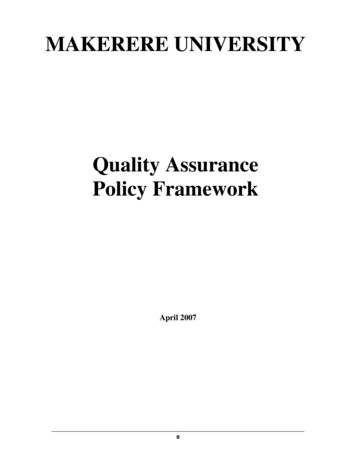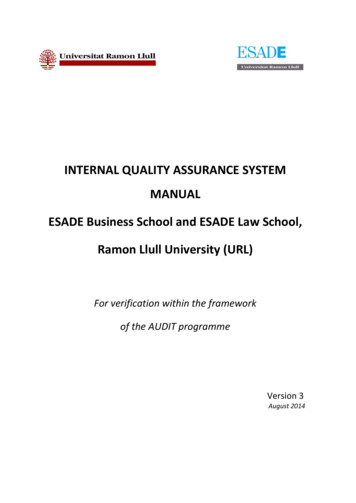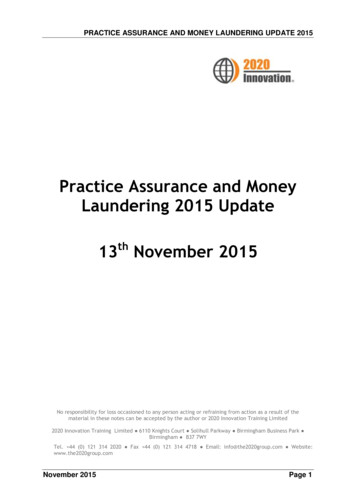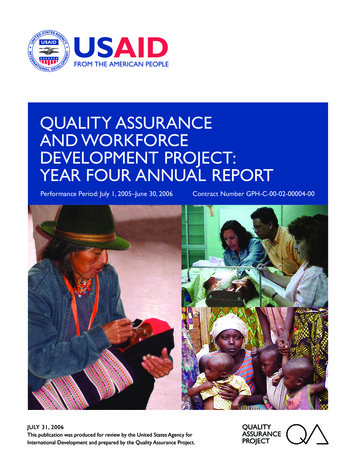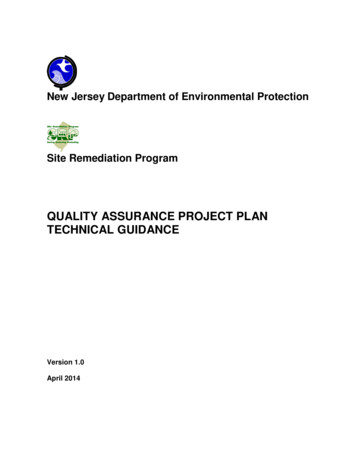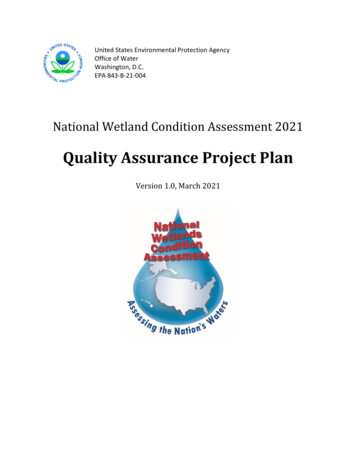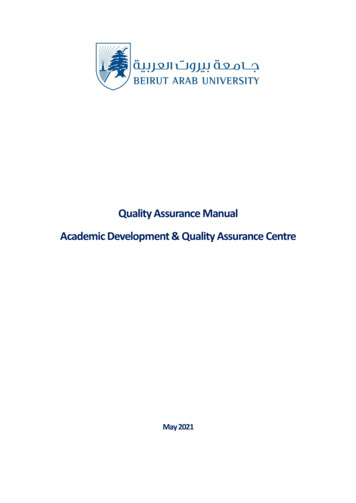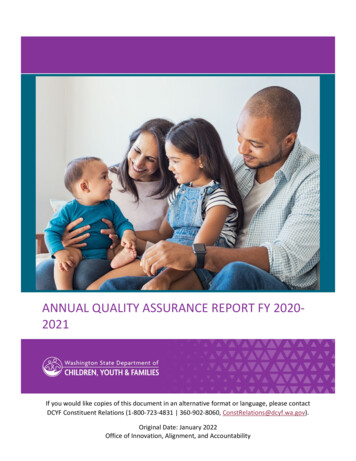
Transcription
ANNUAL QUALITY ASSURANCE REPORT FY 20202021If you would like copies of this document in an alternative format or language, please contactDCYF Constituent Relations (1-800-723-4831 360-902-8060, ConstRelations@dcyf.wa.gov).Original Date: January 2022Office of Innovation, Alignment, and Accountability
ANNUAL QUALITY ASSURANCE REPORT FY 2020-2021CONTENTSExecutive Summary. 1Child Protective Services (CPS) Response Time . 1Children’s Health and Safety in Out-of-Home Care . 1Adherence to Permanency Planning Guidelines . 1Children’s Length of Stay in Out-of-Home Placement . 1Performance Measure Summary . 2Performance Improvement Initiatives. 3Strategic Priorities . 3Child and Family Services Review Program Improvement Plan . 4Permanency from Day One . 5Performance Improvement Infrastructure . 5Conclusion . 5Original Date: January 2022Office of Innovation, Alignment, and Accountability
ANNUAL QUALITY ASSURANCE REPORT FY 2020-2021Executive SummaryState law requires the Department of Children, Youth, and Families (DCYF) to produce anannual Quality Assurance Report, which summarizes the agency’s efforts to provide high-qualityservice to families involved in the child welfare system, ultimately improving the resilience,health, and education of children, youth, and families. This is the 25th report detailingperformance outcome data under RCW 43.216.022 and RCW 74.13.260 that showsperformance in the following specific service areas.Child Protective Services (CPS) Response TimeDCYF responds quickly to allegations of abuse or neglect and implements safeguards to protectchildren who have been abused or neglected from further abuse or neglect by their caregivers.Children’s Health and Safety in Out-of-Home CareDCYF monitors children in out-of-home care, performs health and safety monitoring visits inlicensed foster homes, and works to provide safe placements to children who have beenremoved from their families due to abuse or neglect so that they are not abused or neglected inlicensed care.Adherence to Permanency Planning GuidelinesDCYF works toward placing children in safe, permanent homes as quickly as possible and tracksprogress with reference to permanency within 12 months.Children’s Length of Stay in Out-of-Home PlacementDCYF seeks to minimize the amount of time children spend in out-of-home care prior toreunification or other permanency plan completion.DCYF provides or oversees the provision of services and supports throughout the public childwelfare continuum of care. DCYF’s roles include: Responding to and investigating reports of suspected child abuse and neglect.Providing or overseeing the provision of child and family services and supports to helpparents safely care for their own children whenever possible.Securing safe and stable temporary placements for children until they may safely bereturned home or placed into an alternative safe and stable permanent home.Overseeing the provision of medical, educational, and mental health services to childrenin out-of-home care.Licensing and monitoring foster family and relative homes for temporary placement ofchildren, as well as congregate care or therapeutic facilities to care for children.Providing services and supports to youth transitioning from out-of-home care intoresponsible independent living.1Original Date: January 2022Office of Innovation, Alignment, and Accountability
ANNUAL QUALITY ASSURANCE REPORT FY 2020-2021DCYF tracks performance in many areas of service delivery and oversight in an effort to improveoutcomes. For more detail on these measures and others, visit our Agency PerformanceDashboard.Performance Measure SummaryDCYF is accountable to the Legislature and the public for continuing to improve the childwelfare system. DCYF recognizes no government entity alone can ensure the safety of children.DCYF relies on mandated reporters such as community-based service providers, medicalprofessionals, and school personnel, as well as caring individuals, to speak up on behalf ofvulnerable children by reporting suspected child maltreatment.This data comes from Washington’s Comprehensive Child Welfare Information System (CCWIS),called FamLink. All measures are reported by state fiscal year (SFY), which is July 1 through June30, and display the most current data available for each specific measure. Federal measures arerequired by the federal Administration for Children and Families, for which all states areaccountable, and state measures are additional metrics identified by DCYF as other importantareas of focus.Federal targets in this report reflect federal requirements and performance needed to avoid afederal Program Improvement Plan. These federal measures use an entry cohort approach,which requires the state to wait 12 months or more to determine whether the outcome beingmeasured has occurred. The year label reflects the year of the entry cohort being measured.For more detail, visit our Agency Performance Dashboard.The metrics in the Agency Performance Dashboard are updated annually; therefore, resultsmay vary slightly from what was reported at the time this report was finalized.2Original Date: January 2022Office of Innovation, Alignment, and Accountability
ANNUAL QUALITY ASSURANCE REPORT FY 2020-2021State Target* / FederalTarget**Performance*** 98.5%*98.1%Timely response in non-emergent referrals 97%*98.5%Children who experience recurrence of maltreatment 6%**7.8% 6.8 victimizations / 100,000days**7.0Foster homes receiving health and safety monitoringvisits 10%*12.8%Children visited every month by their caseworker 98%*97.6%Children achieving permanency within 12 months ofplacement 37.9%**39.9%Median number of days children are placed in care Previous year: 596521 7%**7.3%MeasureTimely response in emergent referralsChildren who are abused or neglected while in theplacement and care authority of the statePercentage of children who re-entered care within 12months following reunification with their family* State targets are established by DCYF to set a standard for performance.** Federal targets reflect performance necessary to avoid a federal Program Improvement Plan.*** State measures report performance through SFY 2021. Federal measures report performance for children entering in SFY 2019and SFY 2020 because the measures look forward 12 or 24 months to determine if the outcome being measured occurred in SFY2021.Performance Improvement InitiativesStrategic PrioritiesAfter over a year of planning, drafting, public input, and revisions, DCYF released its first 5-yearStrategic Race and Equity Plan in 2021. The final plan includes six agency-wide priorities – a firstoverarching priority related to Racial Equity, three priorities related to our intention forchildren, youth, and families, and two related to building the necessary capacity needed toaccomplish the first four.1.2.3.4.5.6.Eliminate racial disproportionalities and advance racial equitySafely reduce the number/rate of children and youth in out-of-home care by halfCreate successful transitions into adulthood for youth and young adults in our careCreate a high-quality integrated Birth-8 systemImprove quality and intention of our practiceImprove quality and availability of provider services3Original Date: January 2022Office of Innovation, Alignment, and Accountability
ANNUAL QUALITY ASSURANCE REPORT FY 2020-2021Importantly, these priorities will help the agency to meet its outcome goals for children, youth,and families in Washington, with a specific focus on the populations for which we areresponsible. The resilience, education, and health outcomes that DCYF established in 2018 areoften worse for people of color, and DCYF remains committed to eliminatingdisproportionalities in each of these priorities by race/ethnicity and also family income,geography, sexual identity/gender expression, and disability status.As part of its accountability function, DCYF’s OIAA, in collaboration with program leaders, willestablish targets and metrics for measuring and reporting on each of the six agency priorities.OIAA envisions that each agency priority will have a primary outcome indicator, one or morebalancing indicators to help monitor potential unintended consequences, and a set of driverindicators that lead to the outcome. Once these indicators are developed, they will bemonitored throughout the life of the Strategic Plan. Wherever possible, indicators will bereported as trends over time and will be disaggregated by race/ethnicity, geography, and familyincome.Child and Family Services Review Program Improvement PlanThe Child and Family Services Review (CFSR) is a review conducted by the federal Children’sBureau. The review examines the delivery of child welfare services and the outcomes forchildren and families served by child protective services, foster care, adoption, and otherrelated programs. The review is structured to help states identify strengths as well as areasneeding improvement within their agency and programs. Ultimately, the goal of the review is tohelp states improve child welfare services and achieve positive outcomes for families andchildren who receive services.Washington’s Program Improvement Plan (PIP), which responds to the results of the CFSR finalreport from the Children’s Bureau, was approved by the Children’s Bureau in June 2020 and iscurrently in Quarter 7 of implementation of improvement strategies. All strategies are to beimplemented by June 30, 2022. Washington will then have up to an additional 18 months, oruntil Dec. 31, 2023, to show measurable improvement on specified CFSR outcomes related tosafety, permanency, and well-being. To date, Washington has met 5 of the 10 improvementtargets. The PIP includes strategies under four main goal areas: 1) Workforce Development, 2)Engagement, 3) Assessment and Case Planning, and 4) Permanency. The focus of the PIP is tostrengthen core child welfare practice through reinforcing and enhancing the current tools andstructure available to staff, streamlining, aligning, and integrating processes, and providingpractice support. The work completed through the PIP serves as a foundation and aligns withnew legislative mandates as well as future practice initiatives such as the Family FirstPrevention plan and the Family Practice Model.4Original Date: January 2022Office of Innovation, Alignment, and Accountability
ANNUAL QUALITY ASSURANCE REPORT FY 2020-2021Permanency from Day OneIn the fall of 2018, DCYF was awarded a 7.7 million, five-year grant from the federal Children’sBureau to conduct a project, Permanency from Day One, to support the agency to achievebetter permanency outcomes for children and youth. Two key strategies will enhance earlierand consistent engagement of youth and families in alignment with the CFSR/ProgramImprovement Plan.Enhanced permanent planning meetings were implemented in January 2021 and are now intwenty-two targeted offices to promote successful teaming to engage families, youth, andother key case participants in the case planning process and to address systemic issues thathave been identified as barriers to permanency. The second strategy, enhanced youth-directedrecruitment, was implemented statewide in April 2021 for all legally-free youth not inpermanent placements and encourages youth-directed recruitment strategies for placementand youth voice in case planning and decision-making for placement and recruitment decisions.Performance Improvement InfrastructureOIAA maintains the data infrastructure for aggregating and reporting data from the FamLinksystem to support performance improvement activities in child welfare offices across the state.In addition to providing daily updated reports on health and safety checks and CPS responsetime (initial face-to-face report), OIAA continues to work with the Department of Social andHealth Services Research and Data Analysis division to enhance the priority performancemetrics for those key performance indicators that analysis demonstrated to be significantlyassociated with child safety and permanency. DCYF will use this as an example of a robustempirical process that may be replicated to identify additional priority performance measuresacross the agency.OIAA continues to work to develop a new integrated data analytic environment to supportintegrated performance improvement data aggregation, reporting, analysis and research, asenvisioned in HB 1661.ConclusionAs the public child welfare agency for Washington State, DCYF is held to very high standards forimproving outcomes for children, youth, and families.In addition to continuous quality improvement efforts designed to meet the requirements offederal, state, and judicial oversight entities, DCYF engages in ongoing self-appraisal. DCYFworkers are dedicated to doing the best work possible for vulnerable children, not because ofmandates but because it is the work to which the agency and its many dedicated employees arecommitted.5Original Date: January 2022Office of Innovation, Alignment, and Accountability
ANNUAL QUALITY ASSURANCE REPORT FY 2020-2021DCYF will continue to engage in continuous quality improvement efforts and to increaseresearch-based efforts to protect children and strengthen families so they flourish.6Original Date: January 2022Office of Innovation, Alignment, and Accountability
until Dec. 31, 2023, to show measurable improvement on specified CFSR outcomes related to safety, permanency, and well-being. To date, Washington has met 5 of the 10 improvement targets. The PIP includes strategies under four main goal areas: 1) Workforce Development, 2) Engagement, 3) Assessment and Case Planning, and 4) Permanency.
